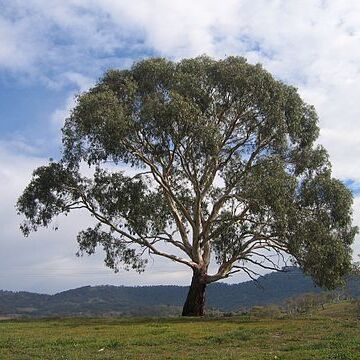Tree to 40 m. Bark smooth throughout, white or red to red-brown, often with horizontal, dark, insect scars. Juvenile leaves opposite, sessile, orbicular, amplexicaul, glaucous, concolorous. Adult leaves alternate, lanceolate to narrowly lanceolate, acuminate; lamina 9–15 cm long, 0.8–2.4 cm wide, glaucous or dull, green, concolorous; lateral vein distinct, at 30°–40°; intramarginal vein to 2 mm from margin; petiole terete, 13–25 mm long. Umbels 3-flowered; peduncle slightly angular or flattened, 3–8 mm long; pedicels absent or to 3 mm long. Buds ovoid, often glaucous; operculum conical, 2–3 mm long, 4–5 mm wide; hypanthium hemispherical, 2–4 mm long, 4–5 mm wide. Fruits hemispherical to subglobular, often glaucous, 4–6 mm long, 5–7 mm wide; disc broad, ascending; valves 3 or 4, exserted.
More
A medium to tall tree. It grows 12-30 m tall. It spreads 10-20 m across. It has an open crown. The bark is red and the old bark is greyish brown. It may turn pink in winter before revealing the new cream bark. The bark peels in strips and flakes off. Young leaves are in pairs and without stalks. The adult leaves are narrow and 15 cm long. They are alternate and have stalks. They are grey-green. The buds are diamond shaped and in threes. They often have a waxy coating. The flowers are small and cream. The capsule is cone shaped or round with valves that stick out.
It grows in temperate regions. It can grow in the subtropics. It needs well drained soils. It can grow in full sun or light shade. It can stand heavy frosts. It grows on grassy forests and woodland on poor mudstone soils in drier areas of Tasmania. It suits hardiness zones 8-9. Tasmania Herbarium. Arboretum Tasmania.
More
Grows on tablelands, hills and slopes in shallowsoils in woodland and open forest.


